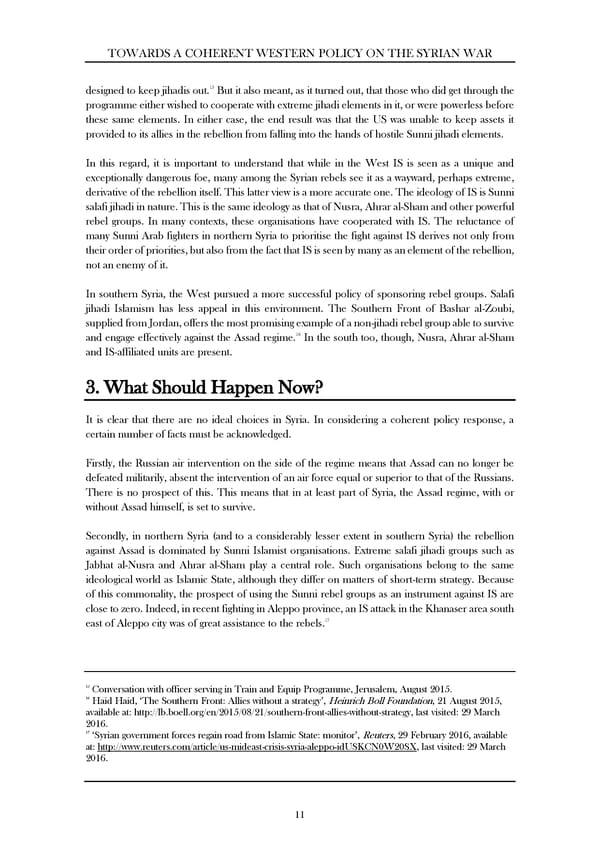TOWARDS A COHERENT WESTERN POLICY ON THE SYRIAN WAR 15 designed to keep jihadis out. But it also meant, as it turned out, that those who did get through the programme either wished to cooperate with extreme jihadi elements in it, or were powerless before these same elements. In either case, the end result was that the US was unable to keep assets it provided to its allies in the rebellion from falling into the hands of hostile Sunni jihadi elements. In this regard, it is important to understand that while in the West IS is seen as a unique and exceptionally dangerous foe, many among the Syrian rebels see it as a wayward, perhaps extreme, derivative of the rebellion itself. This latter view is a more accurate one. The ideology of IS is Sunni salafi jihadi in nature. This is the same ideology as that of Nusra, Ahrar al-Sham and other powerful rebel groups. In many contexts, these organisations have cooperated with IS. The reluctance of many Sunni Arab fighters in northern Syria to prioritise the fight against IS derives not only from their order of priorities, but also from the fact that IS is seen by many as an element of the rebellion, not an enemy of it. In southern Syria, the West pursued a more successful policy of sponsoring rebel groups. Salafi jihadi Islamism has less appeal in this environment. The Southern Front of Bashar al-Zoubi, supplied from Jordan, offers the most promising example of a non-jihadi rebel group able to survive and engage effectively against the Assad regime.16 In the south too, though, Nusra, Ahrar al-Sham and IS-affiliated units are present. 3. What Should Happen Now? It is clear that there are no ideal choices in Syria. In considering a coherent policy response, a certain number of facts must be acknowledged. Firstly, the Russian air intervention on the side of the regime means that Assad can no longer be defeated militarily, absent the intervention of an air force equal or superior to that of the Russians. There is no prospect of this. This means that in at least part of Syria, the Assad regime, with or without Assad himself, is set to survive. Secondly, in northern Syria (and to a considerably lesser extent in southern Syria) the rebellion against Assad is dominated by Sunni Islamist organisations. Extreme salafi jihadi groups such as Jabhat al-Nusra and Ahrar al-Sham play a central role. Such organisations belong to the same ideological world as Islamic State, although they differ on matters of short-term strategy. Because of this commonality, the prospect of using the Sunni rebel groups as an instrument against IS are close to zero. Indeed, in recent fighting in Aleppo province, an IS attack in the Khanaser area south 17 east of Aleppo city was of great assistance to the rebels. 15 Conversation with officer serving in Train and Equip Programme, Jerusalem, August 2015. 16 Haid Haid, ‘The Southern Front: Allies without a strategy’, Heinrich Boll Foundation, 21 August 2015, available at: http://lb.boell.org/en/2015/08/21/southern-front-allies-without-strategy, last visited: 29 March 2016. 17 ‘Syrian government forces regain road from Islamic State: monitor’, Reuters, 29 February 2016, available at: http://www.reuters.com/article/us-mideast-crisis-syria-aleppo-idUSKCN0W20SX, last visited: 29 March 2016. 11
 Towards A Coherent Policy On The Syrian War Page 12 Page 14
Towards A Coherent Policy On The Syrian War Page 12 Page 14